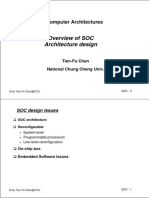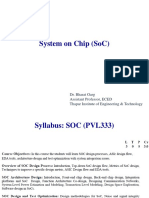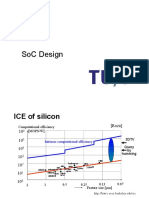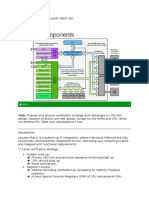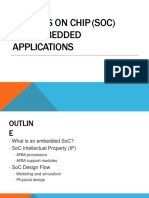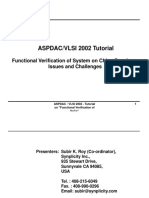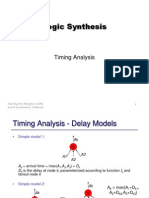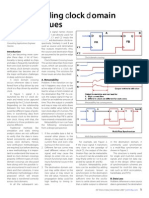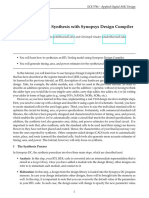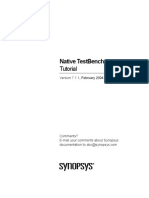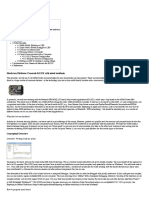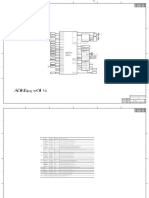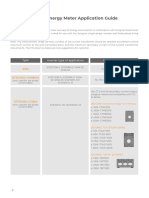SOC Design Process
SOC Design Process
Tian-Sheuan Chang
�SOC Design Process
SOC design flow
System level design issues
Macro design flow
SOC Design Process
Tian-Sheuan Chang
Copyright 2003 All rights reserved
�1. SOC Design Flow
To meet challenges of SOC, design flow changes
from
From a waterfall model to a spiral model
From a top-down to a combination of top-down and
bottom-up
SOC Design Process
Tian-Sheuan Chang
Copyright 2003 All rights reserved
�Traditional ASIC Design Flow
Waterfall model
Recursive
Specification
Development
RTL code
development
From error to where ?
Functional
Verification
Verification Strategy
Tian-Sheuan Chang
SOC Design Process
Design is becoming COMPLEX !
Time-To-Market Pressure
Whats the problem
Handoff are rarely clean
Larger, deep submicron designs
co-development for HW and SW
Physical issues
3
Synthesis
Timing
Verification (VITAL)
Place and Route
Prototype
build and test
Deliver to system integration and software test
Copyright 2003 All rights reserved
�SOC Design Process
Evolution: waterfall to spiral model
Addressing these problems concurrently
Tian-Sheuan Chang
SOC Design Process
Functionality,
Timing,
Physical design and
Verification
Incrementally improving as design converges
Top-down to combination of top-down and
bottom-up
Bottom-up with critical low-level blocks, reuse soft or
hard macros
Copyright 2003 All rights reserved
�Spiral Model
Goal : Maintain parallel interating design flows
SYSTEM DESIGN AND VERIFICATION
PHYSICAL
TIMING
Timing
specification:
I/O timing
clock
frequency
Preliminary
floorplan
Updated
floorplans
Hardware
specification
Software
specification
Algorithm
development
& macro
decompsition
Application
prototype
development
Block timing
specification
Block
selection/
Design
Application
prototype
testing
Block
synthesis
Block
verification
Application
development
Top-level
HDL
Application
testing
Top-level
verification
Application
testing
Updated
floorplans
Trial
placement
SOFTWARE
Top-level
synthesis
Final place and route
Tapeout
5
TIME
Tian-Sheuan Chang
SOC Design Process
Physical
specification:
area, power,
clock tree
design
HARDWARE
Copyright 2003 All rights reserved
�Waterfall v.s. Spiral
Waterfall
Sprial
For large, deep submicron
designs
Parallel development of H/W &
S/W
Parallel verification and synthesis
Floorplaning and P & R in
synthesis process
Use predesigned Macros
(Hard/Soft)
Planned iteration throughput
Work well up to 100K
gate and down .5u
Serial H/W and S/W
development
SOC Design Process
Tian-Sheuan Chang
H/W and S/W development
concurrently : functionality, timing,
physical design, and verification
Copyright 2003 All rights reserved
�Top-Down vs. Bottom-Up
Classical top-down
Begin with spec and decomposition
End with integration and verification
Assuming lowest level block, pre-designed
Too ideal to be easily broken and cause unacceptable iteration
Tian-Sheuan Chang
SOC Design Process
Real-world design team
Mixture of top-down and bottom-up design
Building critical low-level blocks early
Libraries of reusable hard and soft macros helps this
process
Copyright 2003 All rights reserved
�Construct by Correction
Construct by correction
Made the first pass ASAP, and refine later
Why
allow for multiple iterations
Used in Sun Microsystems UltraSPARC design methodology
One of the most successful in Sun Microsystems History
Tian-Sheuan Chang
SOC Design Process
Take from architecture definition through P & R
Foresee impact of architectural decision on final design: area,
power, performance
Target
larger, complex designs
Correction by construct
Make the first pass completely right
Target
small designs
8
Copyright 2003 All rights reserved
�Key to SOC Design Process
Iteration is an inevitable part of the design process
The problem is how large the loop is
Goal
Minimize the overall design time
But How
Tian-Sheuan Chang
SOC Design Process
Planned for iterations
Minimize iteration numbers
especially major loops (Spec to chip)
Local loop is preferred
coding, verifying, synthesizing small blocks
IP clearly help due to pre-verified
Parameterized blocks offer more tradeoff between area,
performance and functionality
Carefully designed spec is the best way to minimize the
loops
9
Copyright 2003 All rights reserved
�Specification Problems
First part of design process
Most crucial, challenging, lengthy phase of project
Why it is so important
Specification is your destination
Tian-Sheuan Chang
SOC Design Process
If you know it exactly, you can spot the error path and fix it
quickly
If not, you may not spot major errors until late
Now the question
When shall you document your specification
Early phase in the design cost less and more valuable
Later phase may only delays the project or be skipped
10
Copyright 2003 All rights reserved
�Purpose of Specification
Specification for Integration
Tian-Sheuan Chang
SOC Design Process
Functional/Physical/ Design requirements
The block diagram
Interfaces to external system
Manufacturing test methodology
Software model
Software requirements
Specification for block Design
Algorithm spec
Interface spec
Authoring guide
Test Spec lint & coverage
Synthesis constraints
Verification environment, tools used
11
Copyright 2003 All rights reserved
�Types of Specifications
Written in natural language
Traditional, ambiguous, incompleteness, erroneous
Formal specification
Tian-Sheuan Chang
SOC Design Process
Desired characteristic (functionality, timing, power,
area,), independent to implementation
Not widely used, important research topic
Executable specification
Description of functional behavior
Parallel with RTL Model in the TestBench
12
Copyright 2003 All rights reserved
�Executable Specification
Procedural language for behavioral modeling
Design productivity
Easy to model complex algorithm
Fast execution
Simple testbench
Tian-Sheuan Chang
SOC Design Process
Tools
Native C/C++ through PLI/FLI
Extended C/C++ : SpecC, SystemC
Verify it on the fly!
Test vector generation
Compare RTL code with behavioral model
Coverage test
13
Copyright 2003 All rights reserved
�Using Executable Specifications
Ensure completeness of specification
Even components(e.g. peripherals) are so complex
Create a program that behave the same way as the system
Avoid unambiguous interpretation of the specification
Tian-Sheuan Chang
SOC Design Process
Avoids unspecified parts and inconsistencies
IP customer can evaluate the functionality up-front
Validate system functionality before implementation
Early feedback from customer
Create early model and validate system performance
Refine and test the implementation of the specification
Test automation improves time-to-market
14
Copyright 2003 All rights reserved
�Executable Spec Motivation
Customer System
Verification,
Error Checking
Bottleneck
Customer System
Tian-Sheuan Chang
SOC Design Process
Paper Spec
Executable Spec
HDL Design
HDL Design
Netlist
HDL TestBench with
C-Interface (PLI/FLI)
Netlist
Layout
Layout
Silicon
Silicon
15
Copyright 2003 All rights reserved
�Time Spent in Design Phases
Conventional
methodologies
Tian-Sheuan Chang
SOC Design Process
Time Spent
Debugging
Product
Planning
System
Design
Logic
Design
14%
12%
18%
20%
Product
Requirements
Mis-communicated
By customer
Physical
Design &
Assembly
13%
50%
Specification incorrectly
Translated or ambiguous
Prototype
Debug
43%
30%
Incorrect
Login in Design
Source: Toshiba/Collet/STOC
16
Copyright 2003 All rights reserved
�Specification Based Design
C/C++ System
Level Model
conversion
HDL
Simulation
Executable Spec.
refine
Analysis
Tian-Sheuan Chang
SOC Design Process
Results
Test Bench
C-to-HDL
Paper Spec.
Interface
(PLI/FLI)
Manual
Test Vector
conversion
(VCD/WAVES)
creates errors
Disconnect
Waveform
between
Compare
System
Model
and HDL
Synthesis
Netlist
Simulation
P&R
Netlist
Simulation
Silicon
17
Copyright 2003 All rights reserved
�System Design Process
IDENTITY
system
requirements
WRITE
preliminary
specifications
DEVELOP
high-level algorithmic model
C/C++/MATLAB/SES/
NuThena/Bones/COSSAP
REFINE and TEST
algorithms
C/C++/COSSAP/SPW/SDL
Tian-Sheuan Chang
SOC Design Process
DETERMINE
hardware/software partition
Characterized library
of hardware/software
macros & interface
protocols
WRITE
WRITE
hardware specification
software specification
DEVELOP
behavioral model for
hardware
DEFINE
interfaces
DEVELOP
prototype of software
PARTITION
DEVELOP
into macros
software
Macro 1
...
hardware/software
Macro n
COSIMULATION
WRITE
preliminary specification
for macro
18
Copyright 2003 All rights reserved
�SoC Design Characteristics
Design Level
RTL / Behavioral > Architectural / VC Evaluation
Design Team
Small, Focused > Multidisciplinary> Multi-Group, Multidisciplinary
Primary Design
Tian-Sheuan Chang
SOC Design Process
Custom Logic > Blocks, Custom Interface> Interface to System /
Bus
Design Reuse
Opportunistic Soft, Firm and Hard > Planned Firm and Hard
Optimization Focus
Synthesis, Gate-level > Floor planning, Block Architecture > System
Architecture
19
Copyright 2003 All rights reserved
�SoC Test Characteristics
Test Architecture
Scan/JTAG/BIST/Custom
> Hierarchical, Parallel scan/JTAG/BIST/custom
Bus Architecture
Custom > Standardized / Multiple app-specific
Tian-Sheuan Chang
SOC Design Process
Verification Level
Gate/RTL > Bus functional/RTL/Gate
> Mixed (ISS to RTL with H/W and S/W)
Partitioning Focus
Synthesis limitation > Functions / Communication
20
Copyright 2003 All rights reserved
�SoC Layout Characteristics
Placement
Flat > Flat with limited hierarchical > Hierarchical
Routing
Flat > Flat with limited hierarchical > Hierarchical
Tian-Sheuan Chang
SOC Design Process
Timing
Flat > Flat with limited hierarchical > Hierarchical
Physical Verification
Flat > Flat with limited hierarchical > Hierarchical
21
Copyright 2003 All rights reserved
�Transition of SoC Design
Methodology
From area-driven to timing-driven design
From block-based to platform-based design
SRAM
uP Core
Flash
Tian-Sheuan Chang
SOC Design Process
uP Core
SRAM
ROM
Logic
ADD
TDD
FIFO
ROM
Serial
MMC I/F
Logic
MPEG
Logic
Logic
SRAM
USB
Soft I/F IP
BBD
PBD
Design Methodology
22
Copyright 2003 All rights reserved
�SoC Design Methodology
Transition of Design Methodology
ADD > TDD > BBD > PBD
Reuse-the key to SoC design
Personal > Source > Core > Virtual Component
Tian-Sheuan Chang
SOC Design Process
Integration approach
IP-Centric vs. Integration-Centric Approach
SoC and productivity
Executable specification
Test automation
Real-world stimuli
Higher-level algorithmic system modeling
23
Copyright 2003 All rights reserved
�2. System-Level Design Issues
Key Aspects of Design Reuse
Fundamentals
Well-designed IP is the key to successful SOC design
System level design guidelines
Tian-Sheuan Chang
SOC Design Process
To produce well-designed IP
To integrate well-designed IP to an SOC design
Driven by the needs of IP integrator and chip designer
Principles behind these guidelines
Discipline
Consistent good practices
Simplicity
The simpler the design, the easier to fix the bugs
Locality
Make timing and verification problem local by careful block and
interface design
24
Copyright 2003 All rights reserved
�Full Custom Design in Reuse
Full custom design
Design that are not from synthesis
Major problems
Tian-Sheuan Chang
SOC Design Process
Performance gain is limited
Non-portable, hard to modify designs
Redesign take time
Limit full custom design for only small part of
design
Even aggressive processor designer uses full custom
only for data path
25
Copyright 2003 All rights reserved
�Interface and Timing Closure
Timing problems due to deep submicron process
Dominated wire delay
Imprecise wireload model due to uncertainty of wire delays
Solution
Tools
Tian-Sheuan Chang
SOC Design Process
Timing driven P&R, Physical synthesis
Tactics for fundamental good design
Register all inputs/outputs of the macro
Unit for floorplan
Register all outputs of the subblock of macro
Unit for synthesis
Exception
Cache interface
Design likes PCI interface that needs glue logic at the interface
26
Copyright 2003 All rights reserved
�Synchronous v.s. Asynchronous
Synchronous
Avoid asynchronous and multi-cycle paths
Tools work best for synchronous design
Accelerate synthesis and simulation
Ease static timing analysis
Tian-Sheuan Chang
SOC Design Process
Register based
Use (positive) edge triggered DFF
Latches shall be used only in small memory or FIFOs
27
Copyright 2003 All rights reserved
�Clocking
Clock planning
Minimize the number of clock domains
Isolate the interface between clock domains
Careful synchronizer design to avoid metastability
Isolate clock generation and control logic
Document the clock scheme
Tian-Sheuan Chang
SOC Design Process
Required clock frequencies and PLL
Interface timing requirements to other parts of the system
PLL
Disabling/bypassing scheme
Ease testing
For hard blocks
Eliminate the clock delay using a PLL
Balance the clock insertion delay
28
Copyright 2003 All rights reserved
�Reset
Synchronous reset
Easy to synthesize
Requires a free-running clock
Asynchronous reset
SOC Design Process
Tian-Sheuan Chang
Do not require a free-running clock
Not affect flip-flop data timing due to separated input
Harder to implement, like clock, CTS is required
Synchronous de-assertion problem
Make STA and cycle-based simulation more difficult
Asynchronous reset is preferred
29
Copyright 2003 All rights reserved
�Internal Generated Reset
Internal generated reset causes unwanted reset
during scan shift
Solution
Tian-Sheuan Chang
SOC Design Process
Force internal generated reset signal inactive during
test
power-on reset
FF
FF
reset to all FF
test_mode_n
30
Copyright 2003 All rights reserved
�Design for Verification
Tian-Sheuan Chang
SOC Design Process
Principle of locality
Plan before design starts
Testbenches should reflect the system
environment
Best strategy
Bottom-up verification
Challenges: developing testbench
Solution
Macros with clean, well-designed interface
High level verification languages + code coverage tool
31
Copyright 2003 All rights reserved
�System Interconnection
Tri-state bus is not good
Bus contention problem
Reduce reliability
One and only one driver at a time
Harder for deep submicron design
Tian-Sheuan Chang
SOC Design Process
Bus floating problem
Reduce reliability
Bus keeper
ATPG problem
FPGA prototyping problem
Multiplexer-based bus is better
32
Copyright 2003 All rights reserved
�IP-to-IP Interface
Direct connection (via FIFO)
Tian-Sheuan Chang
SOC Design Process
Higher bandwidth
Redesign for different IP
Become unmanageable when the IP number increases
Only suitable for design connected to analog block, e.g.
PHY
Bus-based
Eliminate direct link
Layered approach can offer higher bandwidth
All IPs talk to bus only, thus only IP-to-bus problem
The mainstream of current IP-based SOC integration
Choose the standard bus whenever possible
33
Copyright 2003 All rights reserved
�On-chip Bus (OCB)
ARM AMBA
Advanced Microcontroller Bus Architecture
Dominant player
V 3.0 is on the road
Available solution
Tian-Sheuan Chang
SOC Design Process
Synopsys DW_AMBA,
Sonics OCP
VSIA OCB 2.1
WishBone Silicore
IBM CoreConnect
.
34
Copyright 2003 All rights reserved
�AMBA Bus System
SOC Design Process
Tian-Sheuan Chang
35
Copyright 2003 All rights reserved
�Design for Debug: On-chip Debug
Experienced teams assume chip wont work when
first power up and plan accordingly.
Challenges for IP test
Tian-Sheuan Chang
SOC Design Process
IPs are deeply embedded within the SOC design
Disaster to the system and S/W engineers
Solution
Principle: increase controllability and observability
Add debug support logic to the hardware
MUX bus to existing I/O pins
36
Copyright 2003 All rights reserved
�Low Power (1/3)
P = CV 2 f
: switching activity, C : capacitanc e, V : supply voltage, f : frequency
Reduce the supply voltage
Process improvement
Reduce capacitance
Tian-Sheuan Chang
SOC Design Process
Low power cell and I/O library
Less logic for the same performance
Reduce switching activity
Architecture and RTL exploration
Power-driven synthesis
Gate-level power optimization
37
Copyright 2003 All rights reserved
�Low Power (2/3)
Memory
Dominated power consumption
Low-power memory circuit design
Partition a large memory into several small blocks
Gray-coded address interface
Tian-Sheuan Chang
SOC Design Process
32KB
64KB
32KB
38
Copyright 2003 All rights reserved
�Low Power (3/3)
Clock gating
50% - 70% power consumed in clock network reported
gating the clock to an entire block
Block A
Clock
gating the clock to a register
Tian-Sheuan Chang
SOC Design Process
generation
and gating
always @(posedge clk)
if(en)
q <= q_nxt;
Block B
D Q
en
clk
assign clk1 = clk & en;
always @(posedge clk1)
q <= q_nxt;
D Q
en
clk
39
Copyright 2003 All rights reserved
�Design for Test
Memory test
Memory BIST is recommended
Processor test
Tian-Sheuan Chang
SOC Design Process
Chip level test controller (including scan chain controller
and JTAG controller)
Use shadow registers to facilitate full-scan testing of
boundary logic
Other macros
Full scan is strongly recommended
Logic BIST
Embedded stimulus generator and response checker
Not popular yet
40
Copyright 2003 All rights reserved
�3. Macro Design Process
Top-level macro design
Subblocks design
Integrate subblocks
Macro productization
SOC Design Process
Tian-Sheuan Chang
41
Copyright 2003 All rights reserved
�Problem in SoC Era
Productivity gap
Time-to-market pressure
Increasing design complexity
Tian-Sheuan Chang
SOC Design Process
HW/SW co-development
System-level verification
Integration on various levels and areas of expertise
Timing closure due to deep submicron
Solution: Platform-based design with reusable IPs
42
Copyright 2003 All rights reserved
�Design for Reuse IPs
Design to maximize the flexibility
configurable, parameterizable
Design for use in multiple technologies
Tian-Sheuan Chang
SOC Design Process
synthesis script with a variety of libraries
portable for new technologies
Design with complete verification process
robust and verified
Design verified to a high level of confidence
physical prototype, demo system
Design with complete document set
43
Copyright 2003 All rights reserved
�Parameterized IP Design
Why to parameterize IP?
Provide flexibility in interface and functionality
Facilitate verification
Parameterizable types
Tian-Sheuan Chang
SOC Design Process
Logic/Constant functionality
Structural functionality
Bit-widthdepth of FIFOregulation and selection of submodule
Design process functionality (mainly in test bench)
Test events
Events report (what, when and where)
Automatic check event
Others4 (Hardware component Modeling, 1996)
4Authors: Vicktor Preis and Sabine Marz-Rossel, Modeling Highly Flexible and Self-generating Parameterizable Components In VHDL
44Levia and Jacques Rouillard
Copyright 2003 All rights reserved
Collected in book "Hardware component Modeling", 1996, by Jean-Michel Berge, Oz
�IP Generator/Compiler
User specifies
Tian-Sheuan Chang
SOC Design Process
Power dissipation, code size, application performance,
die size
Types, numbers and sizes of functional unit, including
processor
User-defined instructions.
Tool generates
RTL code, diagnostics and test reference bench
Synthesis, P&R scripts
Instruction set simulator, C/C++ compiler, assembler,
linker, debugger, profiler, initialization and self-test code
45
Copyright 2003 All rights reserved
�Logic/Constant Functionality
Logic Functionality
Constant Functionality
SOC Design Process
Tian-Sheuan Chang
Synthesizable code
always @(posedge clock) begin
if (reset==`ResetLevel) begin
end
else begin
end
end
Synthesizable code
assign tRC_limit=
(`RC_CYC > (`RCD_CYC + burst_len)) ?
`RC_CYC - (`RCD_CYC + burst_len) : 0;
For test bench
always #(`T_CLK/2) clock = ~clock;
initial begin
#(`T_CLK) event_1;
#(`T_CLK) event_2;
end
46
Copyright 2003 All rights reserved
�Reusable Design - Test Suite
Test events
Automatically adjusted when IP design is changed
Partition test events to reduce redundant cases when test for all
allowable parameter sets at a time
Debug mode
Tian-Sheuan Chang
SOC Design Process
Test for the specific parameter set at a time
Test for all allowable parameter sets at a time
Test for the specific functionality
Step control after the specific time point
Display mode of automatic checking
display[0]: event current under test
display[1]: the time error occurs
display[2]: expected value and actual value
...
47
Copyright 2003 All rights reserved
�Reusable Design - Test Bench
Use Global Connector to configure desired test
bench
E.g.: bus topology of IEEE 1394
Tian-Sheuan Chang
SOC Design Process
Device 0
Device 0
Device 3
Device 3
Device 1
Device 1
Device 2
Device 2
48
Copyright 2003 All rights reserved
�Characteristics of Good IP
Configurability
Standard interface
Compliance to defensive design practices
Complete set of deliverables
SOC Design Process
Tian-Sheuan Chang
Synthesizable RTL
Verification suite
Related scripts of EDA tools
Documentations
49
Copyright 2003 All rights reserved
�IP Core Macro Design Process
Block specification
DEVELOP functional specification
Completed behavioral
model for HW/SW
cosimulation and test
development
DEVELOP behavioral model DEVELOP testbench
TEST behavioral model
CERATE BEHAVIROAL MODEL
Tian-Sheuan Chang
SOC Design Process
PARTITION design into subblocks
WRITE functional specification
WRITE technical specification
DEVELOP timing constraints
WRITE RTL
RUN Lint
SYNTHESIS
SIMULATE
PERFORM power analysis
Meets timing, power, & area requirements
DEVELOP testbench
Perform these steps
for each subblock
MEASURE test coverage
Coverage tool passes
PASSES - READY FOR INTEGRATION
" Source:
Manual, 2nd
1999.
50 Michael Keating and Pierrr Bricaud, Reuse Methodology
Copyright 2003
All ed.
rights
reserved
�Macro Integration Process
Subblock 1
Subblock 1
Subblock 1
DETERMINE configuration and
GENERATE top-level HDL
Top-level HDL
FUNCTIONAL
VERIFICATION
with reference simulator
GENERATE
synthesis scripts
RUN lint
Tian-Sheuan Chang
SOC Design Process
SYNTHESIZE
with reference library
DEVELOP and RUN
multiple configuration tests
MEASURE
test coverage
Scan insertion, ATPG,
fault simulation
PERFORM final timing
and power analysis
READY FOR PRODUCTION
PRODUCTIZE as soft macro
PRODUCTIZE as hard macro
" Source:
Manual, 2nd
1999.
51 Michael Keating and Pierrr Bricaud, Reuse Methodology
Copyright 2003
All ed.
rights
reserved
�Four Major Phases
Design top-level macro
macro specification; behavior model
macro partition
Design each subblock
Tian-Sheuan Chang
SOC Design Process
specification and design
testbench; timing, power check
Integration subblocks
Macro productization
52
Copyright 2003 All rights reserved
�Specification at Every Level
SOC Design Process
Tian-Sheuan Chang
Overview
Functional requirements
Physical requirements
Design requirements
Block diagram
Interface to external system
Manufacturing test methodology
Software model
Software requirement
Deliverables
Verification
53
Copyright 2003 All rights reserved
�Top-Level Macro Design Flow
Macro specification
DEVELOP detailed
technical specification
Tian-Sheuan Chang
SOC Design Process
CODE behavioral model
C/Verilog/VHDL
CODE testbench
C/Verilog/VHDL/Vera/Specman
Completed behavioral
model for HW/SW
cosimulation and test
development
TEST behavioral model
CERETE BEHAVIROAL MODEL
PARTITION
the block into subblocks
" Source:
1999.reserved
54 Michael Keating and Pierrr Bricaud, Reuse Methodology
Copyright Manual,
2003 2nd
All ed.
rights
�Top-Level Macro Design
Updated macro hardware specification
document
Executable specification
Tian-Sheuan Chang
SOC Design Process
language description
external signals, timing
internal functions, timing
Behavioral model
SystemC, HDL
Testbench
test vector generation, model for under test unit,
monitoring and report
Block partition
55
Copyright 2003 All rights reserved
�Subblock Design Flow
WRITE functional specification
WRITE technical specification
Tian-Sheuan Chang
SOC Design Process
DEVELOP timing constraints
WRITE RTL
RUN Lint
DEVELOP testbench
SIMULATE
Verilog/VHDL
SYNTHESIS
Design Compiler
PERFORM power analysis
PowerCompiler/QuickPower
Meets timing, power, & area requirements
MEASURE testbench coverage
VHDLCover/VeriSure/CoverMeter
Coverage tool passes
PASSES - READY FOR INTEGRATION
" Source:
Manual, 2nd
1999.
56 Michael Keating and Pierrr Bricaud, Reuse Methodology
Copyright 2003
All ed.
rights
reserved
�Subblock Design
Design elements
Tian-Sheuan Chang
SOC Design Process
Specification
Synthesis script
Testbench
Verification suite
RTL that pass lint and synthesis
57
Copyright 2003 All rights reserved
�Linter
Fast static RTL code checker
preprocessor of the synthesizer
RTL purification
syntax, semantics, simulation
Tian-Sheuan Chang
SOC Design Process
timing check
testability checks
reusability checks
Shorten design cycle by avoiding lengthy iterations
58
Copyright 2003 All rights reserved
�Subblock Integration Flow
Subblock 1
Subblock 1
Subblock 1
DETERMINE configuration and
GENERATE top-level HDL
Top-level HDL
FUNCTIONAL
VERIFICATION
Verilog/VHDL simulator
ModelSim, VSS, VCS
RUN lint
Verilint,
VHDLlint
GENERATE
top-level synthesis scripts
Tian-Sheuan Chang
SOC Design Process
SYNTHESIZE
with reference library
Design Compiler
Scan insertion, ATPG,
coverage analysis
Test Compiler, DFTAdvisor,
FastScan/FlexTest
DEVELOP and RUN
multiple configuration tests
Verilog/VHDL simulator
ModelSim, VSS, VCS
PERFORM analysis
QuickPower, Power Compiler
READY FOR PRODUCTION
PRODUCTIZE as soft macro
PRODUCTIZE as hard macro
59
Copyright 2003 All rights reserved
�Subblock Integration
Integration process is complete when
Tian-Sheuan Chang
SOC Design Process
top-level RTL, synthesis script, testbench complete
macro RTL passes all tests
macro synthesizes with reference library and meets all
timing, power and area criteria
macro RTL passes lint and manufacturing test
coverage
60
Copyright 2003 All rights reserved
�Macro Productization
From block integration
DEVELOP specification
for prototype chip
TRANSLATE
Verilog VHDL
SYNTHESIS to
multiple technologies
REGRESSION TEST
on translated code
RUN Pre-sim
on one technology
RUN TESTS
on multiple simulators
Formal Verification
RTL vs. gates
DESIGN chip
SYNTHESIS chip
Tian-Sheuan Chang
SOC Design Process
Scan insertion, ATPG
and coverage analysis
CREATE
user documents: e.g.,
user guide
Verification guide
Integration guide
Test guide
FLOORPLAN
PLACE and ROUTE
VERIFY timing
FABRICATE
TEST chip in demo board
Release
61
Copyright 2003 All rights reserved
�Soft Macro Production
Produce the following components
Verilog version of the code, testbenches, and tests
Supporting scripts for the design
installation script
synthesis script
Tian-Sheuan Chang
SOC Design Process
Documentation
62
Copyright 2003 All rights reserved


